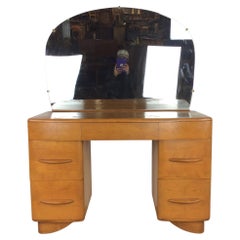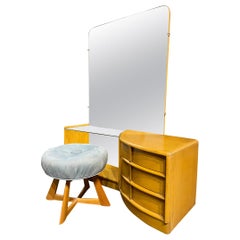Heywood Vanity Round Mirror
Recent Sales
Vintage 1960s American Mid-Century Modern Vanities
Birch, Maple
Vintage 1950s American Mid-Century Modern Vanities
Suede, Mirror, Maple
Vintage 1930s American Art Deco Bedroom Sets
Metal
Mid-20th Century American Mid-Century Modern Vanities
Maple
Mid-20th Century American Art Deco Vanities
Birch
Heywood-Wakefield Co. for sale on 1stDibs
Created by the 19th-century merger of two venerable Massachusetts furniture makers, Heywood-Wakefield was one of the largest and most successful companies of its kind in the United States. In its early decades, the firm thrived by crafting affordable and hugely popular wicker pieces in traditional and historical styles. In the midst of the Great Depression, however, Heywood-Wakefield reinvented itself, creating instead the first modernist furnishings to be widely embraced in American households.
The Heywoods were five brothers from Gardner, Massachusetts, who in 1826 started a business making wooden chairs and tables in their family shed. As their company grew, they moved into the manufacture of furniture with steam-bent wood frames and cane or wicker seats, backs and sides. In 1897, they joined forces with a local rival, the Wakefield Rattan Company, whose founder, Cyrus Wakefield, got his start on the Boston docks buying up lots of discarded rattan, which was used as cushioning material in the holds of cargo ships, and transforming it into furnishings. The conglomerate initially did well with both early American style and woven pieces, but taste began to change at the turn of the 20th century and wicker furniture fell out of fashion. In 1930, the company brought in designer Gilbert Rohde, a champion of the Art Deco style. Before departing in 1932 to lead the Michigan furniture maker Herman Miller, Rohde created well-received sleek, bentwood chairs for Heywood-Wakefield and gave its colonial pieces a touch of Art Deco flair.
Committed to the new style, Heywood-Wakefield commissioned work from an assortment of like-minded designers, including Alfons Bach, W. Joseph Carr, Leo Jiranek and Count Alexis de Sakhnoffsky, a Russian nobleman who had made his name in Europe creating elegant automotive body designs.
In 1936, the company introduced its “Streamline Modern” group of furnishings, presenting a look that would define the company’s wares for another 30 years. The buoyantly bright, blond wood — maple initially, later birch — came in finishes such as amber “wheat” and pink-tinted “champagne.” The forms of the pieces, at once light and substantial, with softly contoured edges and little adornment beyond artful drawer pulls and knobs, were featured in lines with names such as “Sculptura,” “Crescendo” and “Coronet.” It was forward-looking, optimistic and built to last — a draw for middle-class buyers in the Baby Boom years.
By the 1960s, Heywood-Wakefield began to be seen as “your parents’ furniture.” The last of the Modern line came out in 1966; the company went bankrupt in 1981. The truly sturdy pieces have weathered the intervening years well, having found a new audience for their blithe and happy sophistication.
Find a collection of vintage Heywood-Wakefield desks, chairs, tables and other furniture on 1stDibs.
Finding the Right vanities for You
Vintage, new and antique vanity tables have forever felt like personal, intimate sanctuaries of sorts, designed to introduce a level of serenity that feels rare and welcome in our otherwise frenetic days. They’ve been variously known as dressing tables or makeup tables over the years, but no matter what we call them — and whether it's a sophisticated contemporary piece or an iconic vintage Luigi Massoni vanity — vanities have offered a special place for us to get ready for work, an early-morning appointment or lunch date or whatever lies ahead.
“Beauty routines, taking the time to protect what you have, a moment to accessorize, a moment to pause and slow down — these are all so important now as an antidote to our fast and hectic lives,” says Oona Bannon, creative director of Pinch Design in Clapham, South London. “Just thinking about a dressing table makes me feel calm.”
When decorative boxes would no longer suffice as repositories for cosmetics, fragrant oils and perfumes, dressing tables originated in France and England during the 17th century. Men who called the latter home used “shaving tables” — a proto-dressing table — for their grooming routines while women found in dressing tables an oasis for applying makeup, particularly as improvements upon vanity tables equipped them with mirrors and lighting. In the United States, as vanity tables became a seamless component of bedroom furniture, furniture makers working in Chippendale, Rococo and other styles were regularly commissioned to produce these popular items.
Vanity tables have evolved over the years, and while there is lots to love about the ornate carving and pronounced curvilinear forms of Victorian vanities, the clean lines that characterize mid-century modern vanities and the decorative flourishes associated with Art Deco vanities, the main elements of this furnishing are the same. All vanities are about as tall as a standard table with room for seating furniture, which tends to be a small bench, a stool or an armless chair. Many also have special organization features for makeup. Without a chair and a mirror, a vanity would resemble a dresser.
Nowadays, vanities are more than a place to do hair and makeup. They’re a platform to display beauty products and store makeup collections. Vanities are standard in bedrooms, particularly if you’re not lucky enough to have a spacious dressing room or walk-in closet for your dressing table. The better the lighting is in your bedroom or wherever you’ve positioned your vanity table — even if you’ve opted for a moody setting versus a bright one — the more you will benefit from having this personal place of respite to prepare for the day ahead.
Find your antique, new or vintage vanity table today on 1stDibs.

